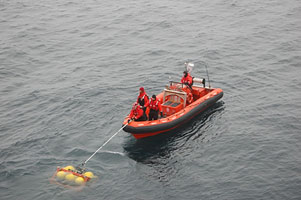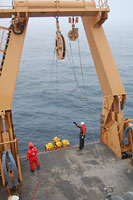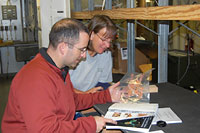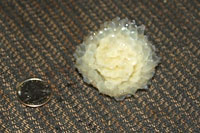

 | |||||||||||||||||||
|
|
Journals 2009/2010Jonathan Pazol
August 8, 2009 Because of the constant light outside, my whole sense of time has been thrown off. For those people who have known me for years, this is the first time in my adult life that I have ever worn a watch, and I am already depending on it. The first of the science experiments to be performed from the Healy was the recovery of two HARP (High-frequency Acoustic Recording Package) moorings by Ethan Roth from the Scripps Institution of Oceanography in San Diego. A year ago, Ethan coordinated the launching of two devices in separate locations to record the sounds in the ocean. Ethan will explain the science behind the equipment at one of our nightly science meetings, so I will save that for a later entry. Twice during the night/following morning, Ethan and three Coast Guard members were lowered overboard in a small boat, called a RHIB (Rigid Hull Inflatable Boat). They rode through the fog to the GPS coordinates, using acoustics to locate the mooring and then estimated the current flow and drift so they could be as close to it as possible when it came to the surface. Once they had that figured out, they sent a unique acoustic signal to the mooring to release its ballast (extra weight) and rise from approximately 300 meters to the surface. The first of the moorings came up right next to the ship. The people in the RHIB used a boat hook to secure the equipment and to get it ready to be hauled onto the ship. Once it was attached, other crewmembers used the winch to lift it onto the fantail (the back, lower deck of the ship).
Later on that morning after getting some sleep, I checked with Ethan, who said he had a project for me. When he pulled up his second mooring he found two unknown organisms attached. Once was a type of brittle star - a long-armed relative of what most people call a starfish. The other was completely unknown. So, knowing that I was a biologist, he wanted me to identify them. This could be a problem. One of the reasons I applied to the ARMADA Project was to learn about oceanography. I have almost no marine biology experience. If Ethan had asked me to identify a tree leaf or explain how DNA copies itself, I could have done it easily, but this might be a challenge. Chris Hedge, a seventh grade science teacher from Indiana and a participant in the NOAA (National Oceanographic and Atmospheric Association) Teacher at Sea Program, and I sat down and tried to identify both organisms. Using Roger Clark's Field Guide to the Benthic Marine Invertebrates of Alaska's Shelf and Upper Slope, we identified the long-armed brittle star as a Gorgoncephalus arcticus - literally the Arctic Gorgon-head (A Gorgon was a creature from mythology with serpents on its head). We could not identify the other organism, but we think it may be some kind of gastropod egg case. Snails and slugs belong to the gastropod class. We placed it in the freezer and plan on bringing it back to Shedd Aquarium to try to identify it further.
The rest of the day I spent talking to people about their duties aboard the ship. I even got in a workout. Running on a treadmill or using an exercise ball as the floor beneath you pitches forward and back and rolls side to side is a totally unique experience. Later we changed time zones and moved the clocks ahead two hours to be in sync with the Canadian icebreaker, which we will meet up with on Monday. We also got our watch assignments. A "watch" is the period of time that we will be officially on the job doing work, and in the case of the research, literally watching several computer screens and monitors as the sea floor is mapped. My watch is from midnight to 8 am, so all of my journals will be using that time frame. Since it was Saturday, the crew has some time to relax, so they showed the movie Wolverine in the helicopter hangar. After the movie and an extra cup of coffee - I had been awake since 6 am, it was off to my watch. |
||||||||||||||||||



